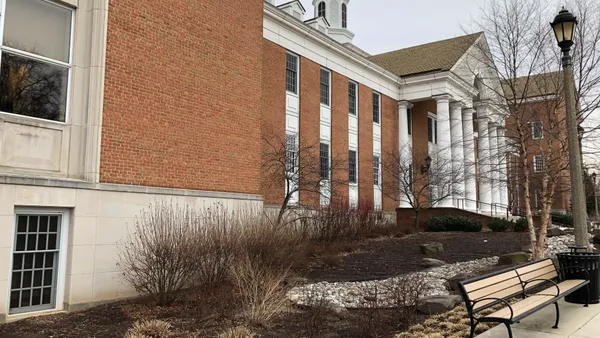Sharp changes in student behaviors, priorities and expectations in recent months have forced higher education institutions to think differently. If the pandemic has taught us anything, it's that there is a tremendous opportunity to embrace new models and approaches in digital teaching and learning to engage students. As colleges and universities now rise to the challenge, and work to create a more sustainable and robust model, it's worth evaluating what is worth keeping and what can be applied more widely — from assessing instructional priorities and online curriculum models to defining what authentic engagement looks like in a zoom session, and the value of peer connections.
Not surprisingly, the challenges that the field of education has faced this year have been well documented. The question is — what new approaches can we turn to? How can educators embrace experimentation and reinvention? What will it take to motivate and retain students?
Looking ahead, three themes stand out to guide how institutions may want to consider the use of digital tools and technologies to navigate this new landscape:
Student experience will be your most valuable investment
Growing competition for students will spur greater focus on student experiences, satisfaction and professional success. This will require an intentional, continuous effort to question assumptions, and create new ways to infuse value, choices and flexibility in educational offerings.
"It starts at the top of the organization" said Wendy Colby, CEO of AccelerEd, an education technology and services company focused on higher ed. "Leaders must fundamentally rethink the way in which instruction is delivered — moving beyond the notion that teaching is about covering content and managing the classroom. Student-centered learning is becoming a catalyst for developing the knowledge, skills and dispositions most relevant to student needs and aspirations. We can leverage technology in ways that allow for self-directed student progress, whether it culminates in a new skill, a degree or a micro-credential."
Educators have an opportunity to improve upon the ad hoc zoom classrooms launched during the pandemic in order to navigate to new and better virtual instruction. Among the changes Colby sees on the horizon are increased emphasis on high-quality online environments that make it more intuitive for students to navigate coursework, and strengthen relationships with peers, mentors and faculty.
The availability of online data, she suggests, will help make these experiences more efficient, engaging and scalable.
Improved student engagement comes not only from technology shifts, but from strong relationships with faculty and the broader learning community. Many faculty have understandably been overwhelmed by their relocation into hybrid or remote environments, without adequate preparation. To that end, forward-thinking institutions, focused on increasing efficiency, will leverage tools and technologies to ease staff load, and streamline administrative functions. Dashboards, learning analytics, student support and collaboration mechanisms will increasingly become vital to building better virtual classrooms.
"Just as important, faculty need professional development opportunities so they're well equipped to redesign courses and interactions with students in this new virtual or hybrid world," Colby added. "Student and faculty engagement and connections are as important to the learning design as the content itself."
Experimentation as a gateway for competitive advantage
To make innovation possible, it's crucial to make room for ongoing experimentation and future-focused conversations, and to also examine barriers such as outdated policies, dated infrastructure and misalignment with changing student demographics and behaviors.
In Colby's experience, that work starts by partnering with academic and business leaders to assess the current state, review what's possible and set the priorities. "For instance, it may involve taking a hard look at traditional degree programs and exploring how broader work-based experiences can be integrated or stacked into these degrees," Colby said. "Or it may entail an examination of the overall program portfolio inside the institution to ensure it meets the demand signals in market and has a sustainable ROI."
Once the strategy is set, it paves the way for devising and iterating on a coherent, student-centered model that integrates the appropriate learning tools to drive the desired outcomes and support student success.
Evolving from transactional to transformational
It's encouraging to see that many high-performing colleges and universities are aiming to deliver learning in more meaningful and scalable ways. While they may not be entirely clear on the value of the tools and technologies they have, they are gaining an appreciation for what it takes to redesign for a future state.
"Technology offers powerful capabilities that institutions are starting to pay attention to," said Colby, "whether it is connecting to real world projects and people, developing a professional portfolio, or building new learning pathways.” She added that the investments institutions make should be closely aligned to helping students master skills, broaden their networks and support their life goals and careers.
"It's important to stay in tune with student expectations, as consumers of education, and find ways to meet those expectations through all phases of the student and career journey," she noted.
Where to start? Start with how you measure success. How are your programs performing today? What do your enrollment trends tell you? Do students persist in your courses? How do they rate your courses? Are you driving the retention you desire?
"There's a lot you can measure today," Colby said. "Talk to your students and faculty. Take the time to develop a dashboard so that you can better understand the health of your university, which will, in turn, help you to determine the best areas for transformation and prioritization."
Small steps and silver linings
Despite the pressure institutions might feel, after a year of living through a pandemic, it's important to remember that there are some silver linings. The experiences that many institutions gained in the past year offer clues into what is possible. There is a great opportunity now to diversify — to improve academic engagement, community building, collaborations, supportive networks and job-ready skills.
"It's an exciting time for institutions to explore how they might reach their full potential," Colby said. "Imagine what a more engaged, student-centric experience can look like — as we open the doors to more experimentation, as we apply technology in the right ways, and as we build bridges between learning and careers."










